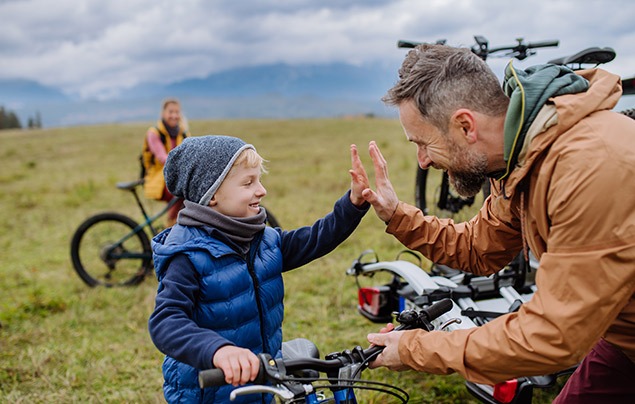How to help kids stick to their New Year’s resolutions
Here’s how parents can teach children to achieve their goals – and set them up for lifelong success.
A child’s New Year’s resolutions to do better in school, read more books or clean their room sound great – until they’re completely forgotten in a few weeks. That’s why mum of two Kathleen Landerholm came up with a goal the whole family could get on board with: two new desserts every month.
Kathleen assumed the dessert resolution would simply be a fun family activity, but it ended up becoming much more. “I think Ellie and Erik have learned how to break up a big goal into smaller increments and keep track of our progress.” says Landerholm. Her kids, aged 10 and 8, are now planning a family book club.
The Landerholms’ family project is a great example of how parents can harness the tradition of New Year’s resolutions to teach children how to set and meet goals.
“Just introducing kids to this idea – thinking about where we want to go and keeping our attention on what we want – is pretty useful,” says William R. Stixrud, a neuropsychologist and co-author of The Self-Driven Child.
Why get kids to make New Year’s resolutions?
While many adults make New Year’s resolutions every year, child and family resolutions are less common. That might be a missed opportunity, says Philip David Zelazo, a professor at the University of Minnesota’s Institute of Child Development.
“This is a nice context for parents to teach their kids some really important things about how to make a plan for the future, set a goal, and then actually achieve it,” he says.
Setting and keeping a family New Year’s resolution builds what psychologists call executive function. This ability is linked to a lifetime of positive outcomes, including preschool readiness, academic achievement, career success, and overall life satisfaction.
But because children’s brains are still developing, complex activities like goal-setting can be challenging.
That’s why experts say parents need to provide appropriate support to help children achieve their goals – and not get frustrated when things don’t go as planned. Here’s how to get started…
The science behind setting and keeping goals
Keeping a New Year’s resolution is hard for adults – and even harder for kids, Zelazo says. That’s because it requires complex links between the prefrontal cortex, which handles goal-setting and progress-tracking, and other brain areas, such as the amygdala, where our gut-level emotions reside. These connections don’t fully mature until well into adulthood.
For instance, setting goals requires the ability to imagine yourself in the future. And while this skill begins to emerge around age five, it doesn’t really take off until kids are well into primary school.
“Kids, especially preschoolers, are really drawn in by what’s going on in the present,” says Cristina Atance, a psychology professor at the University of Ottawa. “Even the short-term future, like ‘after dinner’, doesn’t make much sense to them.”
And while many five-year-olds can plan for the future, Atance says they only begin doing it unprompted at about age eight. That’s also the age when other executive function components blossom, such as working memory – the ability to keep a goal in mind while you’re working on something else.
The ability to make complex plans with interdependent steps takes even longer. It fully emerges at around age 12, according to 2013 research published in the journal Psychology and Neuroscience.
So, if your kids seem to conveniently forget your family’s New Year’s resolution, it’s not because they don’t care. They just don’t have the mental architecture to think about many different things at once.
“Initially it really is going to be an adult who has to help children set the goal and then help them monitor it along the way,” Atance says. “As kids get older, they start to set these goals themselves and need less support from their parents.”
Help kids stick to New Year’s resolutions
A shared family New Year’s resolution is a great opportunity to help children develop their executive function skills, but there’s one catch: You can’t force your goals on your children.
Martin Oscarsson, a psychologist at Stockholm University and author of a 2020 study on New Year’s resolutions, says that externally provided resolutions don’t actually teach kids executive function – and they also tend to fail.
That’s why tying a resolution to something your family cares about will help everyone stay on track. “It can be a cool activity to do with your kids, to sit down and ask, ‘What’s important to you?’” he says. “You want your resolutions to be in line with your values as individuals and as a family.”
Looking for more parenting advice, alongside good news stories from around the world and fun, family-friendly activity ideas? Then sign up for our Family Round-Up newsletter here!
Even if those values don’t quite line up, you can still find a common goal. For instance, if parents are concerned about their long-term health but kids are worried about the health of the planet, that family might resolve to eat two vegetarian meals a week or bike more instead of driving.
“If you’re doing a chart, write your values up at the top. Then if the going gets tough, you can remind yourself why you started,” Oscarsson says.
How to set good goals
To set your family up for success, Zelazo advises making your family resolutions SMART. That means each goal should be…
- – Specific (e.g. playing football instead of watching TV after school)
- – Measurable (a numerical goal, like two times a week)
- – Attainable (nothing too ambitious)
- – Relevant (aligned with your family’s values)
- – Time-bound (with a set start and end date)
Before launching your resolution, Oscarsson recommends brainstorming potential pitfalls and coming up with solutions. For instance, if your resolution is to go on a monthly family bike ride but you know that past adventures have been derailed by missing helmets or flat tyres, plan to get everything ready the night before.
“You don’t want to set kids up for failure, as then they might say, ‘Forget it. I’m never doing this New Year’s thing again,’” Zelazo says. “They’ll get a sense of themselves as having poor self-control or a weak will.”
Psychologists also recommend setting ‘implementation intentions’ – if-then statements that support your goals. So, if your family’s goal is to make new friends, your implementation intention might be, “If we see a neighbour, then we’ll take time to chat with them.”
Don’t sweat the setbacks
When you succeed at meeting your goal for the month, be sure to celebrate. If you fall short, Oscarsson recommends talking about what went wrong and thinking of ways to set yourself up to do better next month. It’s also a good time to chat to you kids about how they can deal with the disappointment and prepare for success in the future.
“A lot of people have this dichotomous view of success in personal goal-setting, like, either you succeed, or you don’t, and once you’ve failed, you’ve failed forever,” he says. “It’s important for kids to learn you’re going to have setbacks, but you can learn from them and get back on track.”















LEAVE A COMMENT
THANK YOU
Your comment will be checked and approved shortly.
WELL DONE,
YOUR COMMENT
HAS BEEN ADDED!
COMMENTS
CUSTOMIZE YOUR AVATAR